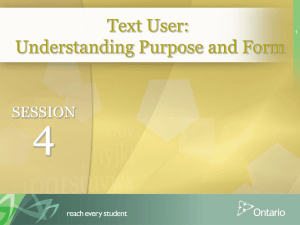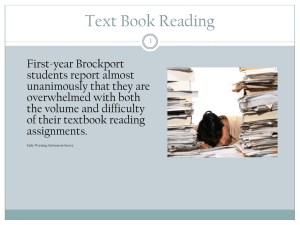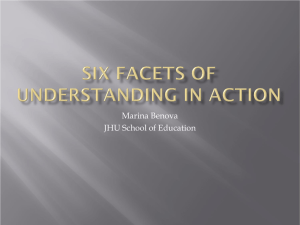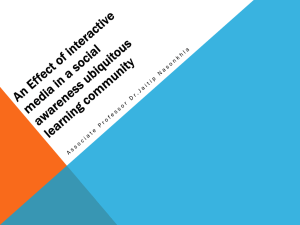Learning, Language, Literacy, and Inquiry in the History
advertisement
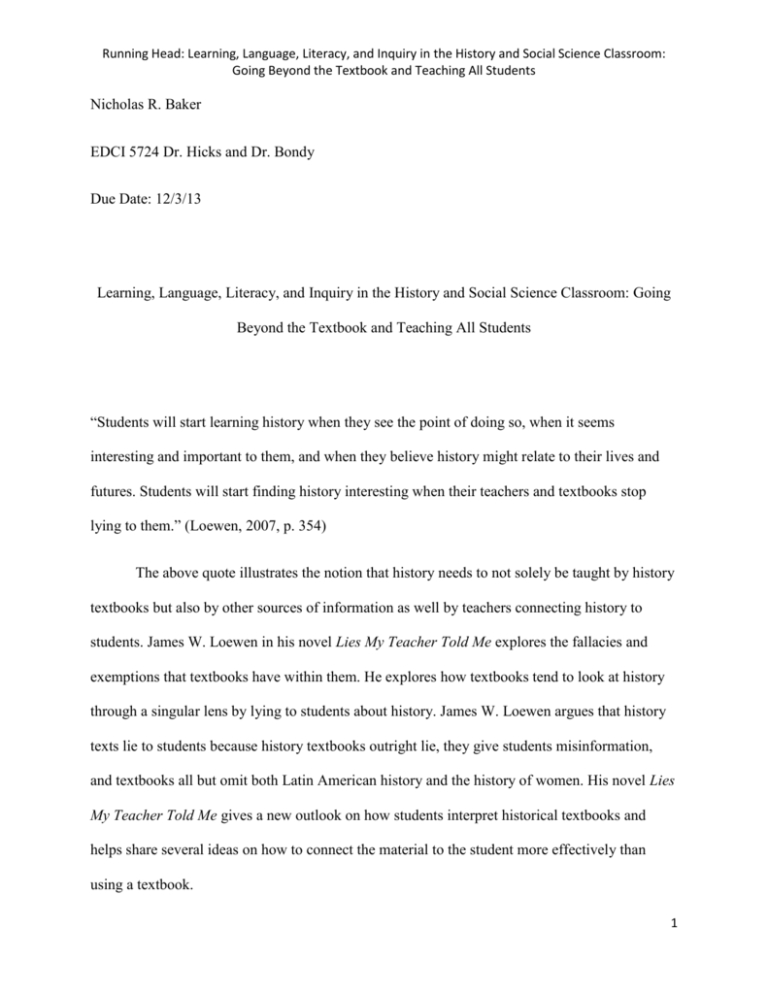
Running Head: Learning, Language, Literacy, and Inquiry in the History and Social Science Classroom: Going Beyond the Textbook and Teaching All Students Nicholas R. Baker EDCI 5724 Dr. Hicks and Dr. Bondy Due Date: 12/3/13 Learning, Language, Literacy, and Inquiry in the History and Social Science Classroom: Going Beyond the Textbook and Teaching All Students “Students will start learning history when they see the point of doing so, when it seems interesting and important to them, and when they believe history might relate to their lives and futures. Students will start finding history interesting when their teachers and textbooks stop lying to them.” (Loewen, 2007, p. 354) The above quote illustrates the notion that history needs to not solely be taught by history textbooks but also by other sources of information as well by teachers connecting history to students. James W. Loewen in his novel Lies My Teacher Told Me explores the fallacies and exemptions that textbooks have within them. He explores how textbooks tend to look at history through a singular lens by lying to students about history. James W. Loewen argues that history texts lie to students because history textbooks outright lie, they give students misinformation, and textbooks all but omit both Latin American history and the history of women. His novel Lies My Teacher Told Me gives a new outlook on how students interpret historical textbooks and helps share several ideas on how to connect the material to the student more effectively than using a textbook. 1 Running Head: Learning, Language, Literacy, and Inquiry in the History and Social Science Classroom: Going Beyond the Textbook and Teaching All Students History has often been a subject that many students have found uninteresting in that it has no relation to their lives and all you do in history class is remember meaningless facts such as dates and names for tests. Students these days feel disconnected with history and do not fully realize history’s true potential just yet. The primary goal of a history teacher is to try and relate the material being studied to every student within their classroom. In order for students to achieve understanding within history, history teachers need to look beyond the notion of remembering useless information such as names and dates. To connect students to history and social studies teachers need to help relate the material to every student’s life in a meaningful way by discussing why we study history and histories impact on everyday life. There have been several scholarly works that have made several suggestions on how to accomplish this seemingly difficult task. Several suggestions are to introduce or expose students to historiography in a variety of ways by presenting them with multiple perspectives through multiple primary and secondary source material. Another suggestion is to build in activities that support understanding through effective planning. The “Six Facets of Understanding” is an example of a framework designed to help students understand and connect history to their lives in a more personal and meaningful way. The final suggestion that many authors support is to have students engage in various Authentic Learning tasks such as structured academic controversies, debates, role plays, simulations, and etc. All of these different methods for helping the instructor to relate the material to the student will be discussed throughout this paper. The first suggestion that many authors support is to expose students to primary and secondary sources that will help students see historical events, people, and places from different points of view. The major goal of using different primary and secondary sources is to help 2 Running Head: Learning, Language, Literacy, and Inquiry in the History and Social Science Classroom: Going Beyond the Textbook and Teaching All Students students see multiple perspectives but it also helps them to form their own arguments, thoughts, opinions, and etc regarding historical topics that facilitate the learning process in that it helps students to understand and connect to the material more. In the chapter “Putting Principles Into Practice: Teaching and Planning” in the text How Students Learn History Mathematics and Science in The Classroom the authors note the importance of using these outside sources to facilitate the learning process when the author’s state: “Moreover, learning history entails teaching students to think quite differently than their “natural” inclinations. As Wineburg suggests, historical thinking may often be an “unnatural” act, requiring us to think outside familiar and comfortable assumptions and world views. Such work, then, requires both substantial knowledge and skill on the part of the teacher to help students learn historical content while expanding their capacities to use evidence, assess interpretations, and analyze change over time “(Ashby, Lee, & Shemilt, 2005, p.180). The authors in the previous passage are making the claim that using a variety of historical evidence using historical skills such as interpreting, evaluating, and analyzing the evidence can have a significant impact on the learning process when teaching students history. The next suggestion that Carol Ann Tomlinson and Jay McTighe promote in their book Integrating Differentiated Instruction + Understanding By Design Connecting Content and Kids is that in order for students to achieve a level of understanding teachers need to construct activities, assessments, and etc around the “Six Facets of Understanding.” (Tomlinson & Tighe, 2006, p. 66). The “Six Facets of Understanding” is made up of six facets or skills that should be 3 Running Head: Learning, Language, Literacy, and Inquiry in the History and Social Science Classroom: Going Beyond the Textbook and Teaching All Students expressed when gauging whether or not a student understands the material. These “Six Facets of Understanding” is essentially to have students “explain, interpret, apply, perspective, empathy, and self-knowledge.” Teachers can use “The Six Facets of Understanding” by utilizing these within frameworks for assignments, assessments, and etc. The authors note the importance of “The Six Facets of Understanding” on students during the learning process when they write, “ Although originally conceived as a set of indicators for understanding, the facets have proven to be useful in generating ideas for “hooking” students around a topic, engaging them in higher order thinking, causing them to consider other points of view, and prompting self-assessment and reflection.” (Tomlinson & Tighe, 2006, p. 116) The next suggestion that academic scholar support is the use of authentic learning tasks within the classroom. According to the author Jim Knight in High Impact Instruction A Framework for Great Teaching he notes that, “Authentic learning always involves a real world issue, a real world product, real world assessment, and real student engagement” (Knight, 2013, p. 226). Students tend to respond well to authentic learning activities because it is meaningful, personally relevant, increases motivation, increases engagement, and empowers students. (Knight, 2013, p. 230-231) He notes that Authentic activities essentially connects the student to the material by empowering them, by creating meaning, by increasing both motivation and engagement to learn the material. John Allen Rossi in his article “The Dialogue of Democracy” also talks about a type of authentic learning task. Rossi (2006) ties the importance of structured academic controversial issues to authentic learning. He notes that there is a specific set of questions that must be asked in all social study classrooms and these questions are designed specifically to illicit many different perspectives that reflect real world problems that people face 4 Running Head: Learning, Language, Literacy, and Inquiry in the History and Social Science Classroom: Going Beyond the Textbook and Teaching All Students every day. The author mentions that authentic learning tasks such as discussion and academic controversy can strengthen the connection between the student and the material. During my internship this past semester I have witnessed my CT form these awesome relationships with her students in that she knows their interests in life and can relate their interest to history. For example, she has a lot of athletes in her class and so she has occasionally referenced a game or something and connected it to history. For example one day we were talking about the Tennis Court Oath during the French Revolution. My CT decides to talk about why they called this the Tennis Court Oath and so she went into detail how tennis was different back then compared to today. I could tell that a lot of students were really interested and so a lot of hands went up in the air asking her to explain, tell them more, and etc. This one idea of relating the material to a sport helped motivate students interest within the class for that day and I noticed that a lot of students started to pay more attention throughout the class period just due to this one connection that my CT made. My CT also not only uses sports to connect to students but she also uses a lot of humor and popular culture examples. For example, when we were discussing the Viceroys during our lesson on Latin American Revolutions she compared Viceroys in Latin American society to the Viceroy’s of the Trade Federation from Star Wars. My CT is no the only person who has connected with students using popular culture references, sport analogies, and humor but I have learned to adapt them as well. For example during one class period I was lecturing on The French Revolution and we were going over the Storming of the Bastille. One student asked me when I was lecturing, “Why did the 3rd estate want to storm the Bastille especially when knowing it was a prison?” I connected the storming of the Bastille with The Dark Knight Rises in that within the movie a character named Bane takes over Gotham a fictional city and one of the first things that he does is to attack the prison to free 5 Running Head: Learning, Language, Literacy, and Inquiry in the History and Social Science Classroom: Going Beyond the Textbook and Teaching All Students the prisoners. I explained to the students that why any revolutionary force would do this is because they feel like the prisoners were being just as oppressed as they were and they were essentially trying to break the chains of the people who they were rebelling against. After I connected this with a popular culture film students seemed to finally understand why the storming of bastille took place within the French Revolution. There are many more examples where this happened during my internship but there are far too many of them to mention. Relating the material to the student in a fun and engaging way can help students achieve a higher level of understanding regarding history. It is our responsibility as future teachers to ensure that students everywhere can relate to the material in a meaningful way and to help explain to students exactly why we study history and its importance to everyday life. Our job is not to hear ourselves talk but to make sure that we help students process, evaluate, and apply their knowledge to their own lives and to help students further their understanding for the historiography with the end goal not necessarily to love history but to appreciate its beauty and its ugliness a little more than before they entered the classroom. 6 Running Head: Learning, Language, Literacy, and Inquiry in the History and Social Science Classroom: Going Beyond the Textbook and Teaching All Students References Ashby, R., Lee, P.J., & Shemilt, D. (2005). “Putting Principles Into Practice: Teaching and Planning.” How Students Learn History Mathematics and Science In The Classroom. (pp. 79-178) Washington D.C.:The National Academy Press. Knight, J. (2013). High Impact Instruction A Framework for Great Teaching. Thousand Oaks, California: Corwin. Loewen, J.W. (2007). Lies My Teacher Told Me Everything Your American History Textbook Got Wrong. New York, NY: Touchstone. Rossi, J.A., (2006, May/June) “The Dialogue of Democracy” The Social Studies, pp. 112-120. Tomlinson, C.A., & McTighe, J. (2006). Integrating Differentiated Instruction + Understanding by Design Connecting Content and Kids. Alexandria, VA: ASCD 7


